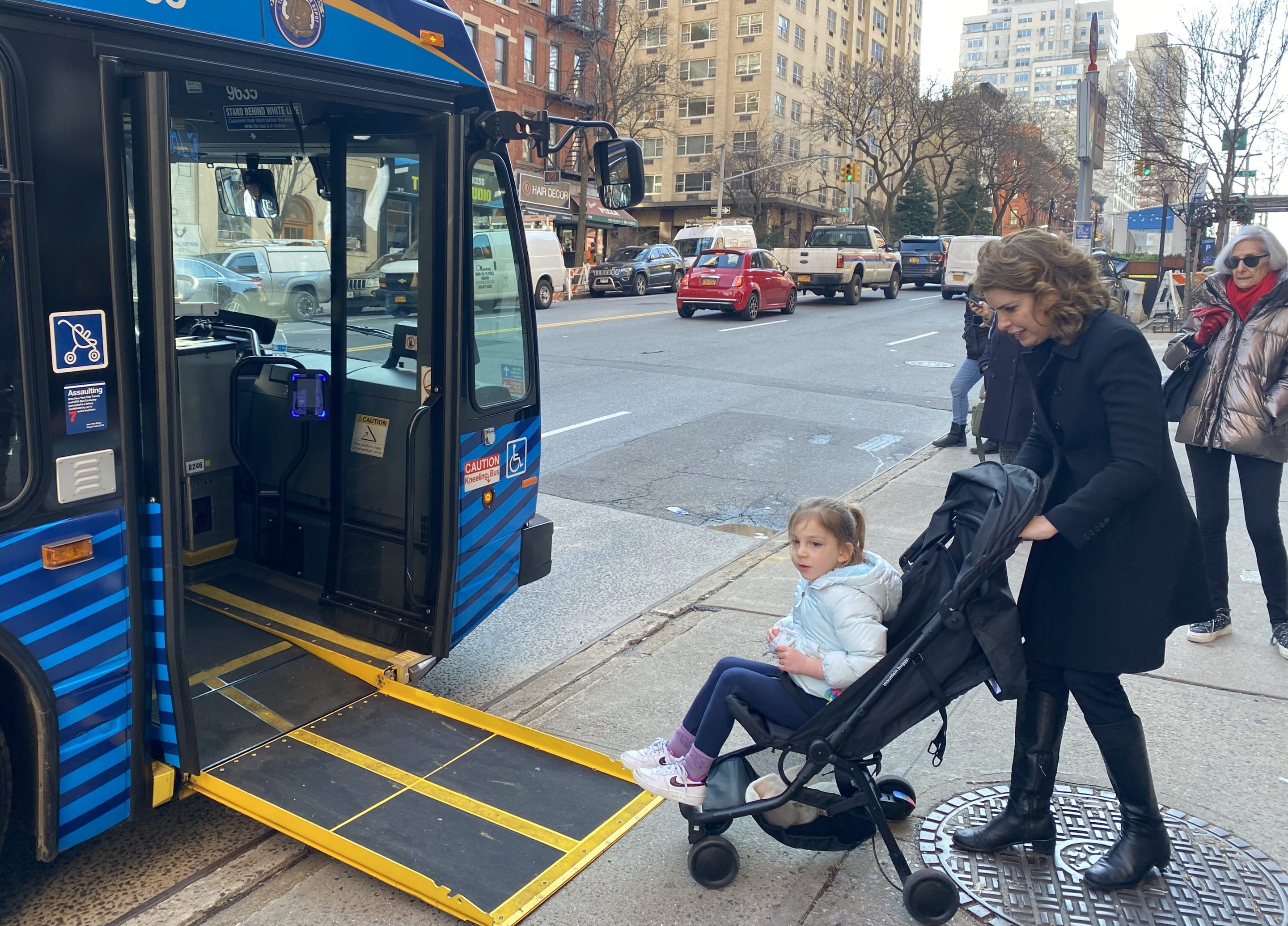Babies on board!
More city buses will have a dedicated space for strollers as the MTA announced on Tuesday plans to expand an existing pilot program for the baby carriages to about 1,000 vehicles in its fleet — though the expansion will only cover one-sixth of the entire bus operation.
The Metropolitan Transportation Authority has for the past five months tested a stroller-only section on 140 buses across just seven lines, allowing parents and caregivers to roll their carriers directly on board rather than being forced to fold them up (while also holding the baby).
Big Apple parents have for years demanded the agency revise its policy, citing the danger and difficulty they had to endure just to board a bus with kids. (And making transit easier for new parents eliminates one of the primary reasons that people buy their first car.)
The pilot program carved out a special spot on a small number of lines in each of the five boroughs, including the Bx23, the B1, the M31, the Q12 and Q50, and the S53 and S93 lines. Officials plan to announce additional routes in the next few weeks.
The project's first steps have already been a "game changer" for parents, according to Christine Serdjenian Yearwood, who founded the group UP-STAND, which advocates for improving accessibility to public transportation for pregnant people and parents.
"For the first time it realistically gives children and caretakers the opportunity to ride the bus safely," Serdjenian Yearwood said at a press conference with MTA officials on the Upper East Side. "The bus used to be a mode of transit that caretakers could not physically manage or opted out of because it was too difficult and unsafe to take children out of the stroller."
Upper East Side Council Member (and mother of four) Julie Menin agreed, and even demonstrated the new space with her youngest daughter Maddie, 4, on a downtown ride with MTA officials and reporters after the presser.
"We are big bus riders and I have to say often times we don’t take a stroller with us because of this very issue, so this is really literally game changing for parents," the lawmaker said.

Parents launched an organized push at the MTA's monthly board meetings in early 2022 to get North America's largest mass transit agency to drop its pram ban, slamming the regulation as a "total nightmare."
Disability activists quickly sounded the alarm in case the MTA sacrificed seats reserved for people using wheelchairs or other mobility devices, but the agency was able to make room on board without impacting those areas.
Drivers and their union TWU Local 100 also worried the pilot project would force transit workers to handle more conflicts over room on the buses between parents and other riders. MTA bus operators already get harassed much more compared to their colleagues on the subways.
The MTA last year convened a panel of parents, disability advocates, and drivers to look at the issues and eventually agreed to allow strollers on some buses as part of the pilot program that started in September.
One advocate who was on that task force praised the agency for heeding their feedback.
"They actually did [take] our recommendations, I think it went pretty well," said Liz Valdez of the Brooklyn Center for Independence of the Disabled. "From a person that uses a wheelchair, I think it’s great."
An operator of the M31, which now offers the stroller section on its route between the Upper East Side and Hells Kitchen, said riders have been behaving.
"I really have no complaints on that, everybody complies," said Dewrell Smith.
There were "no confirmed reported complaints," added Frank Annicaro, the MTA's Senior Vice President for New York City Transit's Department of Buses, though he promised to keep on eye on it as the program grows more than seven-fold.
The expansion will still cover only about one-in-six of the agency's massive fleet of 5,780 buses, but all of the vehicles are retrofittable to allow stroller-only areas for when the agency "decides to move forward," according to Annicaro.
"We want to get this right," the bus chief said. "We’re not just gonna rush things out."
The agency either removed a seat next to the rear door to make room or uses a pair of flip-up seats, depending on the vehicle model, and the buses have a stroller decal at the front to let riders know about the space, though some operators told Annicaro that there could be more signage on board.
Smith, the M31 operator, has seen as many as four strollers on board, with two taking up the space of flip-up seats on buses.
The best routes to expand the pilot are those with a large share of riders with strollers and with a disability, the transit leader said.
The MTA has logged 2,500 stroller rides on buses so far, and the line that has gotten the most use of it according to transit officials is the B1, which traverses southern Brooklyn from Bay Ridge to Manhattan Beach.
Smaller transit agencies in other cities like Chicago, Washington, D.C., and Dallas have long allowed for strollers on buses — so long as there’s room for the other riders.






